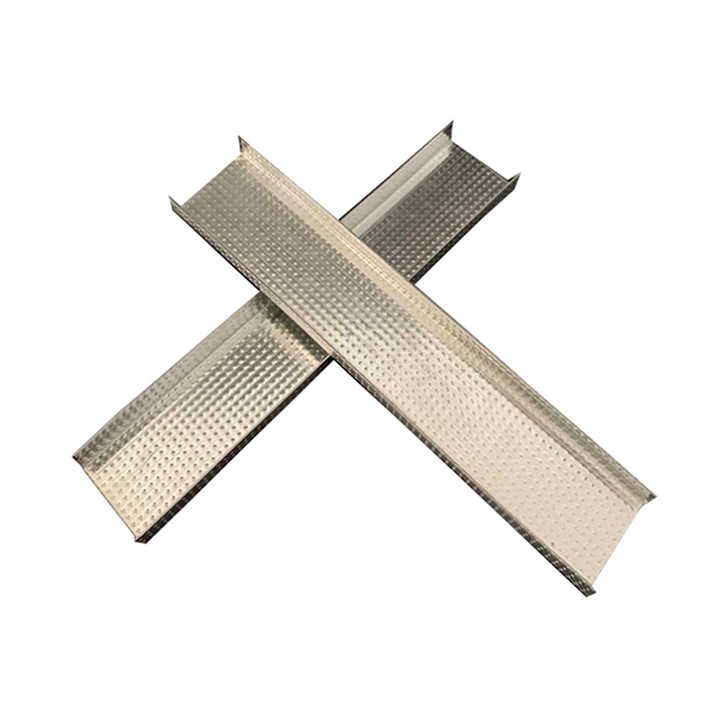Ceiling Grid
Drywall partition
Ceiling channel
Corner Wall angle
Accessories
Steel profiles
Support customization

China manufacturer 50 furring channel sizes
The 50 furring channel refers to a metal channel typically used in suspended ceiling systems or partition frameworks, primarily to support gypsum board, plasterboard, or ceiling tiles. The "50" in the name typically refers to the height of the channel in millimeters (mm), though the width and thickness can vary depending on the specific application.
Here are the common sizes and specifications of a 50 furring channel:
1. Common Dimensions:
Height: 50 mm (commonly referred to as "50 furring channel")
Width: Typically 19 mm, but variations like 20 mm and 25 mm are also available.
Thickness: The thickness usually ranges between 0.30 mm to 0.60 mm, depending on the required strength and the weight of the ceiling or wall material.
2. Standard Sizes:
50 x 19 mm (height x width)
50 x 20 mm (height x width)
50 x 25 mm (height x width)
These sizes are commonly used in commercial and residential ceiling systems and are versatile for different applications. The height (50mm) allows for adequate support for heavy ceiling tiles, while the width (19mm or 20mm) provides a compact and efficient system for supporting plasterboard or gypsum panels.
3. Lengths:
Furring channels come in standard lengths, which typically range from 2.4 meters (8 feet) to 4 meters (13 feet). Longer lengths may be available depending on the manufacturer or regional standards.
4. Coating:
Galvanized Steel: The furring channels are usually made of galvanized steel, which offers corrosion resistance and durability in both dry and moisture-prone environments.
Zinc Coating: The zinc coating typically varies, such as G40, G60, or G90, with higher numbers indicating thicker coatings for better rust protection.
5. Thickness Variations:
0.30mm to 0.40mm: Typically used for light-duty applications, such as ceiling tiles and lightweight drywall systems.
0.45mm to 0.50mm: Standard for most ceiling systems and partition applications.
0.60mm: Used for heavy-duty systems or where greater strength is required for larger ceiling spans or heavier panels.
6. Usage in Ceiling Systems:
Suspended Ceilings: The 50mm furring channel serves as part of the framework in suspended ceilings, supporting gypsum board or other ceiling materials. It is typically attached to the main runners and forms a grid system.
Partition Walls: These channels are also used for creating internal partition walls, particularly in drywall or gypsum board systems, where they provide the structural support for the wall panels.
7. Typical Applications:
Residential: In homes, these furring channels are often used for ceilings in living rooms, kitchens, and bathrooms, especially where suspended ceilings are preferred.
Commercial: In commercial buildings like offices, schools, and hospitals, the 50mm furring channel supports acoustic ceiling tiles or gypsum boards.
Industrial: In factories or warehouses, where ceilings need to be durable and resistant to moisture or chemical exposure.
Conclusion:
The 50mm furring channel is a versatile and widely used component in suspended ceiling systems and partition framing, offering strength and durability for both residential and commercial construction. Available in various widths, thicknesses, and lengths, these channels are adaptable to different construction needs, providing an efficient and cost-effective solution for ceiling or wall installations.
Selection Guide for Ceiling Channel Materials: A Comparison of Light Steel vs. Aluminum in Terms of L
In ceiling construction projects, ceiling channels serve as the critical framework supporting the ceiling surface layer, and their material selection directly impacts the project's quality and service life.
2025-07-06
Designing with Corner Wall Angles: Enhancing Room Aesthetics with Finishing Touches
Introduction In the world of interior design, even the smallest details can make a significant impact on the overall aesthetic of a room. One often overlooked area is the corner wall angles. These seemingly insignificant junctions between w
2025-07-03
Commercial-Grade Corner Wall Angles for Heavy-Duty Construction Projects
In heavy-duty construction projects such as industrial plants, large commercial complexes, and transportation hubs, corners are critical parts of the building structure that constantly face severe challenges. Frequent collisions from heavy equipment and e
2025-06-30
DIY Corner Wall Angle Finishing and Professional Results
In home decoration, DIY corner wall treatments have gained immense popularity among homeowners striving to elevate the quality of their living spaces. Corners are susceptible to damage and highly noticeable, so the way they are handled directly influences
2025-06-27

